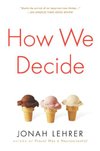
How We Decide

technical name is loss aversion—was
Jonah Lehrer • How We Decide
orbitofrontal cortex,
Jonah Lehrer • How We Decide
The anchoring effect demonstrates how a single additional fact can systematically distort the reasoning process.
Jonah Lehrer • How We Decide
cognitive contretemps—this
Jonah Lehrer • How We Decide
Regardless of how exactly one generates theories of other people's minds, it's clear that these theories profoundly affect moral decisions. Look, for example, at the ultimatum game, a staple of experimental economics. The rules of the game are simple, if a little bit unfair: an experimenter pairs two people together, and hands one of them ten
... See moreJonah Lehrer • How We Decide
Look at poor Frank, a contestant on the Dutch version of Deal or No Deal. He gets off to an unlucky start by immediately eliminating some of the most lucrative briefcases. After six rounds, Frank has only one valuable briefcase left, worth five hundred thousand euros. The Banker offers him #102,006, about 75 percent of a perfectly fair offer. Frank
... See moreJonah Lehrer • How We Decide
asymmetric paternalism.
Jonah Lehrer • How We Decide
insula.
Jonah Lehrer • How We Decide
According to Slovic, the problem with statistics is that they don't activate our moral emotions. The depressing numbers leave us cold: our minds can't comprehend suffering on such a massive scale. This is why we are riveted when one child falls down a well but turn a blind eye to the millions of people who die every year for lack of clean water.
... See more